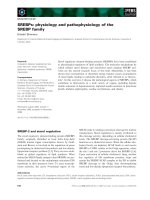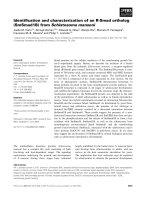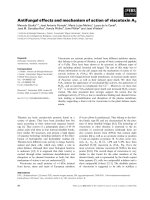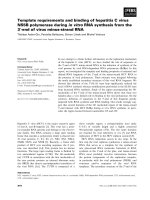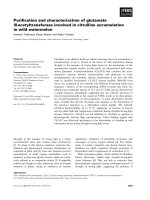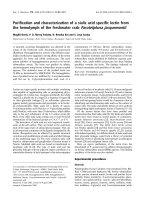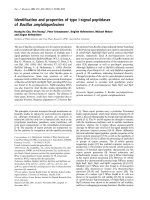Báo cáo khoa học: Kinetic studies and molecular modelling attribute a crucial role in the specificity and stereoselectivity of penicillin acylase to the pair ArgA145-ArgB263 pdf
Bạn đang xem bản rút gọn của tài liệu. Xem và tải ngay bản đầy đủ của tài liệu tại đây (363.47 KB, 8 trang )
Kinetic studies and molecular modelling attribute a crucial role
in the specificity and stereoselectivity of penicillin acylase
to the pair ArgA145-ArgB263
Maya Guncheva
1
, Ivaylo Ivanov
2
, Boris Galunsky
3
, Nicolina Stambolieva
1
and Jose Kaneti
1
1
Institute of Organic Chemistry with Centre of Phytochemistry, Bulgarian Academy of Sciences, Sofia, Bulgaria;
2
Laboratory of
Bioorganic Synthesis, Faculty of Biology, University of Sofia, Bulgaria;
3
Department of Biotechnology II, Technical University
Hamburg-Harburg, Germany
Kinetic experiments with a substrate series of phenylacetyl-
arylamides reveal that at least one polar group in the amine
moiety is required for the proper orientation of the substrate
in the large nucleophile-binding subsite of penicillin acylase
of Escherichia coli. Quantum mechanical molecular model-
ling of enzyme–substrate interactions in the enzyme active
site shows that in the case of substrates lacking local sym-
metry, the productive binding implies two nonsymmetrical
arrangements with respect to the two positively charged
guanidinium residues of ArgA145 and ArgB263. This indi-
cates a crucial role of the specified arginine pair in the sub-
strate- and stereoselectivity of penicillin acylase.
Keywords: enzyme kinetics; molecular modelling; nucleo-
phile specificity and stereoselectivity; penicillin acylase.
Penicillin G acylases (PA, EC 3.5.1.11) from different
sources have been widely studied because of their applica-
tion as industrial biocatalysts for hydrolytic and synthetic
transformations in the production of semisynthetic b-lactam
antibiotics [1,2] and for their possible new uses in synthetic
organic chemistry [3–5]. PA has been identified as an
N-terminal nucleophile hydrolase following specific cata-
lytic and processing mechanisms [6–8]. During evolution,
the catalytic properties of enzymes have been optimized
for their function in vivo. However, their application as
industrial biocatalysts often requires transformations of
substrates not encountered in nature under reaction condi-
tions differing from physiological ones. Protein design
aimed at rational optimization and/or effective screening of
enzymes for new transformations requires the study of their
specificity with appropriate substrate series. Convenient
substrates should also contain sensitive reporter groups for
spectrophotometric or fluorimetric detection to facilitate
rapid and reliable kinetic measurements.
The acyl specificity of PA is restricted to aromatic
molecules and has been investigated mainly with substrates
containing phenylacetyl, phenylglycyl, mandelyl, pyridyl-
acetyl or other arylacetyl moieties [9–13]. Our previous
studies of PA catalysed transfer reactions with a nonspecific
acyl moiety, benzoxazol-2-on-3-yl-acetyl, have shown that
the hydrolytic ability of PA for such substrates is drastically
decreased, but that its nucleophile specificity is more
pronounced and the synthetic capacity is, respectively,
increased. In the latter system PA behaves as a typical
transferase [14,15]. The nucleophile or S
1
¢ [16] specificity of
the most studied PA from Escherichia coli has been probed
in both hydrolytic and kinetically controlled transfer
reactions, but the quantitative data published so far are
scarce. Specificity constants for PA catalysed hydrolysis of
phenylacetyl derivatives with variable leaving groups such
as b-lactam nuclei, amino acids, peptides and nucleosides
have been shown to differ up to three orders of magnitude
[13,17]. Structural, site-directed mutation and kinetic inves-
tigations have identified several active site residues import-
ant for the S
1
¢–P
1
¢ interactions relevant to the catalytic
mechanism [18–21]. There are, however, still questions to be
answered about the alternatives of interactions in the large
nucleophile binding subsite. In the substrate series studied
here the phenylacetyl moiety is kept constant and the
leaving group structures are confined to arylamines. The
expected output is a set of comparative kinetic data, which
combined with molecular modelling based on available
crystallographic data, could give more detailed information
on PA nucleophile binding subsite and the mechanism of
transformations with this class of compounds. These data
can be used further for rational design of substrates for
different purposes, e.g. screening of protein engineered PA
for new enzymatic transformations, and analysis of kinetics
Correspondence to N. Stambolieva or J. Kaneti, Institute of Organic
Chemistry, 1113 Sofia, Bulgaria. Fax: +359 2 70 02 25,
E-mail: , ;
/>Abbreviations: PA, penicillin acylase; PhAc, phenylacetyl moiety;
6APA, 6-aminopenicillanic acid; PG or PhAc-6APA, penicillin G;
PhAc-NH
2
, phenylacetamide; PhAc-MCA, phenylacetyl-4-methyl-
coumaryl-7-amide; NIPAB, 2-nitro-5-phenylacetamidobenzoic acid;
iso-NIPAB, 2-nitro-4-phenylacetamidobenzoic acid; NIPPA,
N-(5-nitro-2-pyridyl)-phenylacetamide; PhAc-pNA, phenylacetyl
4-nitroanilide; PhAc-pAB, 4-phenylacetamidobenzoic acid;
PhAc-mAB, 3-phenylacetamidobenzoic acid; PhAc-oAB, 2-phenyl-
acetamidobenzoic acid; PhAc-bNA, phenylacetyl 2-naphtylamide.
Enzyme: penicillin acylase (EC 3.5.1.11).
(Received 2 February 2004, revised 29 March 2004,
accepted 16 April 2004)
Eur. J. Biochem. 271, 2272–2279 (2004) Ó FEBS 2004 doi:10.1111/j.1432-1033.2004.04170.x
of ÔinvisibleÕ substrates [22]. The correlation of the kinetic
parameters with the nucleophile structure could also allow
the design of substrate mimetics for more effective acyl
transfer [23].
Materials and methods
Materials
Penicillin acylase from E. coli was supplied by AntibioticÒ
Razgrad (Bulgaria) and was purified by anion-exchange
chromatography as described previously [24]. All other
reagents were analytical grade from Fluka or Sigma.
Substrates
Penicillin G (PG, PhAc-6APA) was from Sigma. Phenyl-
acetamide was synthesized by drop-wise addition of
phenylacetyl chloride to concentrated ammonia. The
product precipitates. The other studied substrates were
synthesized by acylation of the corresponding arylamines
(Table 1) with phenylacetyl chloride. The phenylacet-
amidobenzoic acids were synthesized in aqueous–organic
media under slight excess of NaOH according to the
Schotten–Baumann procedure [25]. 2-Nitro-5-phenyl-
acetamidobenzoic acid was prepared as described [26].
The other substrates were obtained in dry organic
solvents in the presence of organic base (pyridine,
N-methylmorpholine). The solvents used for the synthesis
of the respective phenylacetyl arylamides were tetrahydro-
furan
1
for phenylacetyl-4-nitroanilide, N-(5-nitropyridin-
2-yl)-phenylacetamide and phenylacetyl-2-naphtylamide;
dioxan for phenylacetyl-4-methylcoumaryl-7-amide. Phe-
nylacetyl chloride was added drop-wise into the arylamine
solution at 0 °C. Then the reaction mixture was allowed
to reach room temperature and the reaction was further
carried out at the boiling point of the organic solvent.
The products were recrystallized: the phenylacetamido-
benzoic acids, phenylacetyl-4-nitroanilide, phenylacetyl-
4-methylcoumaryl-7-amide and phenylacetamide from
ethanol; N-(5-nitropyridin-2-yl)-phenylacetamide from
CHCl
3
/hexane; phenylacetyl-2-naphtylamide from acet-
one/petroleum ether. The yields varied in the range
60–90%. The synthesized substances were identified by
their melting point, elemental analysis and
1
H-NMR
spectra. In the case of phenylacetamido-benzoic acids and
phenylacetyl-4-methylcoumaryl-7-amide the melting points
are in good agreement with previously published data
[27,28]. The newly synthesized N-(5-nitropyridin-2-yl)-
phenylacetamide has a melting point of 145–146 °C;
Table 1. Phenylacetyl arylamides used as probes for the nucleophile binding subsite of E. coli PA.
5
Substrate (abbreviation) Structure of the leaving amine
Method to trace the course of
the reaction
1 NIPAB Spectrophotometric
k ¼ 380 nm, e ¼ 11600
M
)1
Æcm
)1
2 PhAc-MCA Spectrofluorimetric
k
ex
¼ 380 nm, k
em
¼ 460 nm
3 PhAc-pNA Spectrophotometric
k ¼ 410 nm, e ¼ 7900
M
)1
Æcm
)1
4 NIPPA Spectrophotometric
k ¼ 370 nm, e ¼ 11200
M
)1
Æcm
)1
5 PhAc-pAB Spectrophotometric
k ¼ 295 nm, e ¼ 6450
M
)1
Æcm
)1
;
Discontinuous colour assay
6 PhAc-bNA Spectrofluorimetric
k
ex
¼ 335 nm, k
em
¼ 420 nm
7 PhAc-mAB Discontinuous colour assay
8 PhAc-oAB Spectrofluorimetric
k
ex
¼ 340 nm, k
em
¼ 420 nm;
Spectrophotometric
k ¼ 325 nm, e ¼ 3500
M
)1
Æcm
)1
Ó FEBS 2004 The role of ArgA145-ArgB263 pair in penicillin acylase selectivity (Eur. J. Biochem. 271) 2273
calculated for C
18
H
11
N
3
O
3
: C 60.70, H 4.31, N 16.33,
found: C 60.83, H 4.58, N 16.18;
1
HNMR:3.81(s,2H,
C
6
H
5
-CH
2
), 7.21–7.36 (m, 5H, C
6
H
5
), 8.24–9.18 (m, 3H,
Pyr-H), 11.46 (s, 1H, NHCO).
Kinetic measurements
The PA-catalysed hydrolysis of the arylamide bond was
followed by the absorbance or fluorescence change during
the release of the product (see Table 1 for the corresponding
spectral characteristics). The hydrolysis of 3-phenylacet-
amidobenzoic acid (PhAc-mAB) and 4-phenylacetamido-
benzoic acid (PhAc-pAB) was followed by a discontinuous
colour assay, based on the diazotization-coupling method
[29]. The hydrolysis of the reference substrates phenylacet-
amide (PhAcNH
2
) and PhAc-6APA was followed by
HPLC as described earlier [13]. The kinetic experiments
were performed at 25 °Cin50m
M
phosphate buffer
pH 7.0, containing 10% dimethyl sulfoxide. The concen-
tration range of each substrate was based on its solubility
and typically was 20–300 l
M
. For steady-state kinetic
analysis of substrates of high K
m
values this range was not
always the most appropriate. For such cases the specificity
constants k
cat
/K
m
were determined from pseudo-first order
traces. The enzyme concentration was in the range
50–100 n
M
, determined by active site titration [30] using
2-nitro-5-phenylacetamidobenzoic acid (NIPAB) as a sub-
strate. The steady-state kinetic parameters were derived
from the initial rates for at least seven different substrate
concentrations using the nonlinear regression data analysis
software
ENZFITTER
[31].
Modelling and analysis of interaction energies
within the active site
Initial graphic visualization and manipulation of molecules
were performed using the program
DS VIEWERPRO
(Accelrys
Corporation, San Diego, CA, USA; http://www.
accelrys.com/dstudio/ds_viewer/index.html). Models were
based on the crystallographic coordinates of the enzyme–
substrate complex AsnB241Ala mutant E. coli PA with PG
[19] (Brookhaven Protein Data Bank [32], entry number
1fxv). Approximate docking of an Asn residue in place of
Ala as in the native enzyme in this structure was performed
using the
SWISS
-
PDB VIEWER
program [33] (http://www.
expasy.ch/spdbv/mainpage.htm). The atoms of the phenyl-
acetyl group were arranged close to the position found in the
complex with PG [19]. The bond lengths and valence angles
of the nitroaniline moiety were taken from the X-ray data
for the system cyclophilin A and the tripeptide substrate
succinyl-Ala-Pro-Ala-p-nitroanilide [34].
The structures of enzyme–substrate complexes with
docked substrates were refined by another procedure. First,
we chose a selection of limited number of amino acid
(oligopeptide) residues in the immediate vicinity of the
substrate in order to estimate the contribution of each
protein fragment to the interaction energy of the complex.
Then, the resulting ÔsupermoleculeÕ was subjected to explicit
optimization of the position of substrate within the Ôtrun-
cated active siteÕ. In this step, coordinates of all amino acid
or oligopeptide fragments were kept frozen at their values
from the X-ray structure, while all coordinates of substrate
atoms were optimized using AM1 semiempirical MO
calculations [35] as implemented in the
MOPAC
93 program
package [36]. This procedure as such has two caveats. First,
the assumption of fixed amino acid positions is equivalent to
freezing the enzyme process to a time point at which
substrate binding is complete, and the catalytic act has not
started yet. This moment is convenient from the viewpoint
of required computing power. Second, and more important,
is that the optimization of substrate position within the
catalytic cavity of PA encounters multiple energy minima.
Therefore, the way the best of these, i.e. the global
minimum, was chosen ÔautomaticallyÕ was crucial. We used
the eigenvector-following optimization [37] with stringent
convergence criteria and unconstrained geometry search.
Thus, we expected the search method to skip shallow local
minima on the respective potential energy surface, and
hoped to gain some enhanced probability to achieve a
significantly populated minimum. This is essentially another
docking procedure, using semiempirical AM1 quantum
mechanical calculations.
The final, more precisely docked structures, were visual-
ized using
MOLEKEL
[38]. The interaction energies within the
optimized complex and their decomposition into Coulombic,
polarization, charge transfer and exchange repulsion com-
ponents were analysed using the procedure of Morokuma
[39] at the RHF STO-3G level of MO theory [40], as
implemented in the
GAMESS
-
US
computational package [41].
The modelling process was performed for a selection of
amino acid residues within the active site consisting of 10
fragments, including the substrate, and comprising a total of
298–312 atoms depending on substrate size.
Results and discussion
Substrate structure and kinetic results
We selected the leaving groups in the studied phenyacetyl
arylamides considering both steric and electronic factors.
The structures listed in Table 1 are of different size and
hydrophobicity, without and with electronegative substitu-
ents of different orientation, and the majority possesses
chromogenic or fluorogenic properties. The kinetic para-
meters of the PA-catalysed hydrolysis of the studied
phenylacetyl arylamides are compared in Table 2. The
substrates are arranged in a decreasing order of the ratio
of their specificity constant to the specificity constant of
phenylacetamide (PhAc-NH
2
), used as a reference because
it implies no interactions in the large S
1
¢ binding subsite.
NIPAB has a specificity constant of the same order of
magnitude as one of the most specific substrate of PA–PG.
Phenylacetyl-4-methylcoumaryl-7-amide (PhAc-MCA) has
a specificity constant almost equal to that of the reference
substrate. The remaining PhAc-arylamides have 5–50 times
lower specificity constants. Thus, specificity constants for
the best (NIPAB) and the worst (2-phenylacetamidobenzoic
acid; PhAc-oAB) substrates in this series differ by more than
two orders of magnitude, which reflects the sensitivity of the
enzyme towards the structural changes in the leaving
arylamine moiety. These changes account for differences
in K
m
and k
cat
, which implies that S
1
¢–P
1
¢ interactions, both
in the ground and transition states, are important for the
catalytic efficiency of PA with the studied substrates.
2274 M. Guncheva et al.(Eur. J. Biochem. 271) Ó FEBS 2004
The proper orientation of COOH and NO
2
substituents in
the aminoaryl moiety favours the hydrolytic reaction of
NIPAB. PhAc-arylamides with only one (NO
2
or COOH)
substituent are substantially worse substrates. The data for
the PA catalysed hydrolysis of PhAc-Asp and PhAc-Glu
[13] and our data for PhAc-pAB, PhAc-mAB and PhAc-
oAB (Table 2) imply that the COOH group has to be posi-
tioned as in NIPAB for effective catalysis. The incorporated
pyridyl moiety in N-(5-nitro-2-pyridyl)-phenylacetamide
(NIPPA) might lead to alternative interactions within the
active site, resulting in different orientation and binding.
Molecular modelling
The X-ray structures of PA (wild-type and mutant)
complexes with different ligands [19,20,44,45] indicate the
presence of a single roughly conical groove, the hydro-
phobic part of which accommodates the phenylacetyl
moiety of the ligands. The more polar aminic moiety resides
in the open part of the groove, surrounded by several polar
amino acid residues. This part of the enzyme can be
considered as its S
1
¢ binding subsite. Substrate binding
induces conformational changes involving the ArgA145-
PheA146 fragment of the protein chain, acting as a flap, first
opening and then closing the groove [45]. The catalytic
reaction presumably occurs when the ionized carboxyl
group of PG approaches the guanidine side chain of
ArgA145, thereby turning the scissile amide bond inside the
groove towards SerB1. SerB1 is involved in the hydrogen
bond network around ArgB263 and AsnB241 (Fig. 1).
Hydrogen bonds observed in the free PA (PDB ID: 1pnk)
are believed to maintain the appropriate three-dimensional
Table 2. Steady-state kinetic data for PA catalysed hydrolysis of phenylacetyl arylamides with different leaving groups. Reaction conditions: 25 °C,
50 m
M
phosphate buffer pH 7.0, 10% dimethyl sulfoxide. The SD from the mean value was < 10% in three determinations. Substrate numbering is
the same as in Table 1.
Substrate k
cat
(s
)1
)10
6
· K
m
(
M
)
10
)5
· k
cat
/K
m
(
M
)1
Æs
)1
)
Ratio to reference
PhAc-NH
2
PhAc-6APA
a
50 10 50 20
1 NIPAB 20 15 13.3 5.3
iso-NIPAB
b
100 80 12.5 5.2
2 PhAc-MCA 3.2 12 2.7 1.1
PhAc-NH
2
a
50 200 2.5 1.0
3 PhAc-pNA
c
20 400 0.5 0.2
4 NIPPA 7.8 510 0.15 0.06
5 PhAc-pAB 3.0 300 0.1 0.04
6 PhAc-bNA 1.9 200 0.095 0.039
7 PhAc-mAB 2.5 400 0.06 0.024
8 PhAc-oAB 2.3 630 0.04 0.016
a
The kinetic constants for PA catalysed hydrolysis of PG and PhAc-NH
2
are determined at the same reaction conditions and are used as
reference values.
b
Data for iso-NIPAB from Ref [42].
c
Literature data for this substrate: k
cat
50 s
)1
, K
m
120 l
M
at 25 °C in10 m
M
phosphate buffer pH 7.5, 0.1
M
KCl [42]; k
cat
14 s
)1
, K
m
130 l
M
)at30°Cin50m
M
phosphate buffer pH 7.0 [43].
Fig. 1. The hydrogen bond network (broken
lines) around ArgB263 as derived from X-ray
coordinates of amino acid residues in penicillin
acylase [19] and AM1 docking calculations. The
three N atoms of the side chain d-guanidino
group of this residue are involved in
H-bonding as follows: Ne with the O atom of
the main chain CO group of the TrpB240;
Ng
1
shares H bonding with O atom of the CO
group of LeuB387 together with O atom of
c-OH of SerB386; Ng
2
is in H bonding with
Od
1
of AsnB241. In the free enzyme, a brid-
ging water molecule W360 bonded with c-OH
of SerB386 and Ng
2
of ArgB263, respectively,
closes the H-bond network. Atom colours
used are: C, green; N, blue; O, red; S, yellow.
Ó FEBS 2004 The role of ArgA145-ArgB263 pair in penicillin acylase selectivity (Eur. J. Biochem. 271) 2275
arrangement of catalytically essential amino acid residues
[44,46]. The same H-bond network is evidenced also in the
complexes of wild-type PA with phenylacetic acid and PG
sulphoxide (PDB ID: 1pnl and 1g7) and in the complex of
Asn241Ala mutant with PG (PDB ID: 1fxv) [19,20,45].
With the exception of a recent publication [47], ArgB263 has
not been discussed as a residue potentially involved in
S
1
¢–P
1
¢ interactions. ArgB263 is fully conserved in 11 PA
sequences (
CLUSTALW
alignment; />clustalw) and can be assigned the role of Ômain coordinatorÕ
of the catalytic hydrogen bond network. This implies that
the ArgB263 residue could be involved both in catalysis and
productive binding.
Graphic simulation of the interactions of arylamide
substrates with the nucleophile binding subsite of PA
indicates that the arylamide moiety is accessible by solvent.
Along with the suggestion of a large volume ( 1000 A
˚
3
)of
this subsite [48], it implies relatively weak interactions
between the leaving group and the selected polar amino acid
residues. This is in good agreement with the K
m
values for
PhAc-NH
2
(200 l
M
) and PhAc-OMe (160 l
M
) [46], both
substrates practically lacking S
1
¢–P
1
¢ interactions, and with
the K
m
values (200–600 l
M
) for the majority of the studied
PhAc-arylamides more than one order of magnitude higher
than the corresponding value of PG. The same deduction
is also well in line with the diversity of the tolerated P
1
¢
structures by PA. The situation significantly changes for
NIPAB hydrolysis, where a negatively charged substituent
is present in the m-position, along with a polar one in the
p-position to the scissile amide bond. Modelling of the
possible hydrogen bond network around ArgB263 accom-
modating the polar leaving group of NIPAB accounts for
significant electrostatic interactions between polar amino
acid residues and the latter substrate (Fig. 2, bottom left).
A similar, although less hydrogen bonded, arrangement of
NIPAB is possible with ArgA145, with or without the
participation of bridging water molecules. In the model
complex with NIPAB, the phenylacetyl moiety of this
substrate is placed in the close vicinity of the catalytic SerB1
and AsnB241 from the oxyanion hole, essential for stabil-
ization of the tetrahedral intermediate. Experimental data
[21] for the efficient hydrolysis of NIPAB catalysed by the
ArgB263Lys mutant PA and the lack of hydrolytic activity
for the ArgB263Leu PA mutant (K
m
value increased
15-fold) also imply that this residue participates in the
productive binding of NIPAB. However, Alkema et al.[21]
reject this role of ArgB263 and propose TyrB31 as a possible
basic residue interacting with this substrate. Their conclu-
sion is based on pH dependence studies and the observed
pK
a
value of 9, considered too low for guanidino group
(pK
a
12.5). Indeed, it is hard to assume such an alteration in
the polar environment of this side chain. It is formed by the
Fig. 2. The optimized positions of some arylamide substrates docked in the active site of penicillin acylase by AM1 calculations. Amino acid residues of
the enzyme are at their X-ray coordinates [19]. Substrates having local symmetry of the leaving group (top left and bottom right) bind at an
equilibrium point of the electrostatic action of the two guanidinium residues. Substrates with leaving groups lacking local symmetry (for NIPAB,
bottom left, COO
–
is close to ArgB263; for iso-NIPAB, top right, NO
2
is close to ArgA145) can assume either of the two directions depending on
the orientation of the polar group.
2276 M. Guncheva et al.(Eur. J. Biochem. 271) Ó FEBS 2004
O atoms of the main chain CO groups of LeuB387 and
TrpB240, Od
1
atom of AsnB241, and Oc atom of SerB386
and is expected to stabilize the positive charge of ArgB263.
All of these views remain arguable, but one should always
be careful when addressing experimental macroscopic pK
a
values to a specified functional group in an enzyme
molecule, as shown by Carpenter and Fersht [49,50].
Considerations of the suggested hydrogen bond network
around ArgB263 provide no reasonable explanation of the
PA activity with substrates like PhAc-pAB, PhAc-mAB,
PhAc-oAB vs. phenylacetyl 4-nitroanilide (PhAc-pNA),
NIPAB and iso-NIPAB, but it suggests an explanation of
the 16-fold difference between the K
m
values of PhAc-MCA
and PhAc-bNA (Table 2). The determined lower K
m
value
for the PhAc-MCA could be ascribed to a more favourable
hydrogen bonding interaction between ArgB263 and the
remote carbonyl group of MCA, which interaction is
absent with the bNA moiety.
The analysis of differences observed between the k
cat
values for the studied PhAc-arylamides is more complex.
On one hand, structural data for the PA–substrate inter-
actions in the transition state are missing and only a
GRID
computational modelling approach to the tetrahedral inter-
mediate in PA presents some indications of the importance
of ArgB263 for enzyme–substrate interactions [48]. On the
other hand, the determined catalytic constants are apparent
ones, with varying relative contributions of individual rate
constants and their discussion is not straightforward.
An important detail of the modelling experiments with
possible arrangements of substrates within the X-ray struc-
ture of PA requires special attention. One should note that
substrates bearing aminic moieties without local symmetry
can adopt at least two spatially different alignments within
the active site. This should be particularly true for substrates
having polar substituents, e.g. NIPAB (Fig. 2, bottom left)
with the carboxylate group directed towards ArgB263. The
possible alternative orientation of NIPAB in the S
1
¢ binding
subsite towards ArgA145 (analogously to Fig. 3, right)
follows the mode of binding of PG in the complex with
AsnB241Ala mutant PA [19]. This three-dimensional differ-
ence in substrate arrangements within the PA active site
certainly has to do with the stereoselectivity of this enzyme.
Quantum mechanical molecular modelling
AM1 optimization of substrate position and conformation
within our selection of PA active site fragments places
NIPAB somewhat closer to ArgB263 than to ArgA145. The
distances between the polar CO
2
–
and O(NO) and positively
charged guanidinium fragments of ArgA145 and ArgB263
are listed in Table 3. AM1 docking calculations show
uniformly that PG and phenylacetyl arylamides have the
benzyl fragment PhCH
2
placed in the hydrophobic groove
of the active site. The polar fragments of all substrates align
between the positively charged ArgA145 and ArgB263, with
the carboxyl group of PG somewhat closer to ArgA145,
while nitroarylamides have the polar NO
2
at roughly equal
distances from the two guanidinium fragments. More
important, the COO
–
groups of arylamides on Figs 2 and
3 are at approximately equal distances from the two
positively charged fragments as well, Table 3. The com-
plexes of selected phenylacetyl arylamides with the men-
tioned selection of amino acid and oligopeptide residues
from the active site of PA are shown on Figs 1,2 and 3.
The AM1 docked complex of PG is shown on Fig. 1. The
discussed hydrogen bond network around ArgB263 is
retained also with arylamide substrates and involves their
polar carboxylate and/or nitro groups. For substrates with
leaving groups, lacking local symmetry, e.g. NIPAB, PG, as
well as with the poor substrate PhAc-mAB, we were able to
model complexes with the mentioned selection of amino
acid residues around the catalytic site of PA, having the
COOH group directed to either ArgA145, or ArgB263
(Fig. 3). These results emphasize the caveat of multiple
minima for the accommodation of substrate within the
active site of PA. More importantly, however, the possibility
of polar group orientation towards either ArgA145 or
ArgB263 indicates a source of substrate specificity and
stereoselectivity of PA at the molecular level. Experimental
observations on the pH dependence of PA enantioselectivity
[51] coincides well with the above conclusions. Computa-
tional modelling of PA enantioselectivity in the reverse
reaction of amide bond synthesis also has pointed at the role
of ArgB263 in this process [48].
The decomposition of interaction energies within the
studied complexes, shown in Table 4, indicates relatively
Fig. 3. Penicillin acylase stereoselection of
achiral arylamide substrate with a leaving group
lacking local symmetry. The simultaneous
strong electrostatic action of the two positively
charged residues, ArgA145 and ArgB263, on
the negatively charged COO
–
in the aminic
part determines the position of the substrate
within the S
1
¢-binding subsite.
Table 3. Distances (A
A
˚
) between polar substrates groups (CO
2
–
and
NO
2
) and the two ArgB263 and ArgA145 residues of penicillin acylase as
a result of AM1 optimization of the corresponding substrate position in
the selected PA fragment environment.
Arg residue
NIPAB PG PG sulfoxide
O(CO)-N
a
O(NO)-N
a
O(CO)-N
a
O(CO)-N
a
ArgA145 9.8 10.2 8.2 12.1
ArgB263 6.6 6.7 8.7 6.7
a
N is one of the nitrogen atoms of the corresponding guanidino
group.
Ó FEBS 2004 The role of ArgA145-ArgB263 pair in penicillin acylase selectivity (Eur. J. Biochem. 271) 2277
smaller contributions of ArgA145 to individual terms of the
interactions: electrostatic, charge transfer, and polarization.
On the contrary, contributions from ArgB263 are signifi-
cantly larger and generally comparable to those of the
nucleophile SerB1, GlnB23-PheB24, AlaB69, believed to
be the dominant substrate binding fragments of PA. In
addition, substrates with leaving groups lacking local sym-
metry may have their polar group directed towards ArgB263.
In this case calculated interaction energies with the rest of the
complex are larger than in the case of substrates with the
polar group oriented towards ArgA145. The interaction
energy of ArgA145 itself with the rest of the complex is large
when the substrate’s polar group is directed toward it,
and small when the polar group points to ArgB263. The
interactionenergyofArgB263withtherestofthecomplex,
however, remains large and practically constant irrespective
of the orientation of the polar group. While a significant
part of the latter relatively large interaction energy can be
attributed to the hydrogen bonding network around
ArgB263, the mentioned findings give another argument
favouring the importance of ArgB263 in substrate binding to
PA. The pronounced difference in interaction energies of the
two arginine residues shows certain capability of the pair of
polar guanidinium groups to discern between orientations of
substrates in the active site. These two arginines should thus
contribute significantly to enzyme stereoselectivity. A more
detailed account of the Morokuma analysis [39] of inter-
action energies in PA active site complexes will be given
elsewhere (J. Kaneti, S. Bakalova, I. Ivanov, M. Guncheva
& N. Stambolieva, unpublished data).
Conclusions
Kinetic and molecular modelling studies with a substrate
series of phenylacetyl arylamides reveal that at least one
polar group in the amine moiety of the substrate is essential
for its proper orientation in the large nucleophile binding
subsite of penicillin acylase.
AM1 docking calculations based on the crystal structure
[19] give evidence of polar environment around ArgB263.
It consists of O atoms of the main chain CO groups of
LeuB387 and TrpB240, Od
1
atom of AsnB241 and Oc atom
of SerB386 and is expected to stabilize the positive charge of
ArgB263.
The possible nonsymmetrical accommodation of sub-
strates with respect to the pair of ArgA145 and ArgB263 of
PA gives rise to notable three-dimensional stereochemical
differences in their corresponding enzyme–substrate com-
plexes, and to a certain degree of stereoselectivity. The pair
ArgA145 and ArgB263 significantly influences the S
0
1
specificity and contributes to the appropriate docking of
the substrate.
References
1. Bruggink, A., Ross, E.C. & de Vroom, E. (1998) Penicillin acylase
in the industrial production of b-lactam antibiotics. Org. Process
Res. Devel. 2, 128–133.
2. Bruggink, A., ed. (2001) Synthesis of b-Lactam Antibiotics.
Chemistry, Biocatalysis and Process Integration.KluwerAcademic
Publishers, Dordrecht, the Netherlands.
3. Didziapetris, R., Drabing, B., Schellenberger, V., Jakubke, H D.
& Svedas, V. (1991) Penicillin acylase-catalysed protection
and deprotection of amino groups as a promising approach in
enzymatic peptide synthesis. FEBS Lett. 287,31–33.
4. Waldmann, H., Heuser, A. & Reidel, A. (1994) Selective enzy-
matic deprotection of hydroxy and amino groups in carbo-
hydrates and nucleosides. Synlett 65–67.
2
5. Sheldon, R.A., van Rantwijk, F., van Langen, L.M., Wegman,
M.A., Cao, L. & Janssen, M.H.A. (2001) Biocatalysis and
biocatalyst in the synthesis of b-lactam antibiotics. In: Synthesis of
b-Lactam Antibiotics. Chemistry, Biocatalysis and Process Integ-
ration (Brugging, A., ed.), pp. 137–143. Kluwer Academic
Publishers, Dordrecht, the Netherlands.
6. Brannigan, J.A., Dodson, G., Duggleby, H.J., Moody, P.C.,
Smith, J.L., Tomchick, D.R. & Murzin, A.G. (1995) A protein
catalytic framework with an N-terminal nucleophile is capable of
self-activation. Nature 378, 416–419.
7. Suresh, C.G., Pundle, A.V., SivaRaman, H., Rao, K.N.,
Brannigan, J.A., McVey, C.E., Verma, C.S., Dauter, Z., Dodson,
E.J. & Dodson, G.G. (1999) Penicillin V acylase crystal structure
reveals new Ntn-hydrolase family members. Nat. Struct. Biol. 6,
414–416.
8. Dodson, G.G. (2000) Catalysis in penicillin G amidase – a member
of the Ntn (N-terminal nucleophile) hydrolase family. Croatica
Chemica Acta 73, 901–908.
9. Cole, M. (1969) Deacylation of acylamino compounds other than
penicillins by the cell-bound penicillin acylase of E. coli. Biochem.
J. 115, 741–745.
10. Cole, M., Savidge, T. & Vanderhaeghe, H. (1975) Penicillin acy-
lase (Assay). Methods Enzymol. 43, 699–721.
11. Pohl, T. & Waldmann, H. (1995) Enhancement of the enantio-
selectivity of penicillin G acylase from E. coli by Ôsubstrate tuningÕ.
Tetrahedron Lett. 36, 2963–2966.
12. Fuganti, C., Rosell, C.M., Rigoni, R., Servi, S. & Tagliani, A.
(1992) Penicillin acylase mediated synthesis of formyl-
cephamandole. Biotechnol. Lett. 14, 543–546.
Table 4. Calculated STO)3G interaction energies (kcalÆmol
)1
) for various substrates with the larger 10-fragment selection of protein residues within
the active site of penicillin acylase. Superscripts at total energies indicate the direction of nonsymmetrical polar groups towards either ArgA145 or
ArgB263. Partial energy contributions from the two arginine residues and the substrate are given vs. measured K
m
values given in Table 2.
Substrate E
I total
E
ArgA145
E
ArgB263
E
Substrate
10
6
· K
m
(
M
)
PG 10
NIPAB )60.4
145
)0.5 )4.2 )3.7 15
iso-NIPAB )61.3
145
)0.6 )4.0 )3.6 80
)121.5
263
)0.4 )4.2 )3.7
PhAc-mAB )61.7
145
)2.4 )4.0 )4.4 400
)63.4
263
)0.2 )3.9 )7.4
PhAc-pNA )56.4 )0.5 )4.1 )23.3 400
PhAcNHPh )55.9 )0.3 )4.0 )5.8
2278 M. Guncheva et al.(Eur. J. Biochem. 271) Ó FEBS 2004
13. Galunsky, B., Lummer, K. & Kasche, V. (2000) Comparative
study of substrate- and stereospecificity of penicillin G amidases
from different sources and hybrid isoenzymes. Chem. Monthly
131, 623–632.
14. Stambolieva, N., Mincheva, Z., Galunsky, B. & Kalcheva, V.
(1992) Penicillin amidase-catalysed transfer of low specific acyl
moiety. Synthesis of 7-benzoxazolonylacetamido-desacetoxy-
cephalosporanic acid. Enzyme Microb. Technol. 14, 496–500.
15. Stambolieva, N., Mincheva, Z. & Galunsky, B. (1998) Kinetic
Comparison of penicillin amidase-catalysed transfer of nonspecific
and specific acyl moieties to 7-ADCA. Biocat. Biotrans. 16,
225–232.
16. Schechter, I. & Berger, A. (1967) On the size of the active site
in proteases. I. Papain. Biochem. Biophys. Res. Commun. 27,
157–162.
17. Youshko, M.I., Chilov, G., Scherbakova, T. & Svedas, V.K.
(2002) Quantitative characterization of the nucleophile reactivity
in penicillin acylase-catalyzed acyl transfer reactions. Biochim.
Biophys. Acta 1599, 134–140.
18. Brannigan, J.A., Dodson, G.G., Done, S.H., Hewitt, L., McVey,
C.E. & Wilson, K.S. (2000) Structural studies of penicillin acylase.
Appl. Biochem. Biotechnol. 88, 313–319.
19. Alkema, W.B.L., Hensgens, C.M.H., Kroezinga, E.H., de Vries,
E., Floris, R., van der Laan, J M., Dijkstra, B.W. & Janssen, D.B.
(2000) Characterization of the b-lactam binding site of penicillin
acylase of E. coli by structural and site-directed mutagenesis
studies. Protein Eng. 13, 857–863.
20. McVey, C.E., Walsh, M.A., Dodson, G.G., Wilson, K.S. &
Brannigan, J.A. (2001) Crystal structure of penicillin acylase
enzyme-substrate complexes: Structural insights into the catalytic
mechanism. J. Mol. Biol. 313, 139–150.
21. Alkema, W.B.L., Prins, A.K., de Vries, E. & Janssen, D.B. (2002)
Role of a Arg
145
and b Arg
263
in the active site of penicillin acylase
of Escherichia coli. Biochem. J. 365, 303–309.
22. Alkema, W.B.L., Floris, R. & Janssen, D.B. (1999) The Use
of chromogenic reference substrates for the kinetic analysis of
penicillin acylases. Anal. Biochem. 275, 47–53.
23. Bordusa, F. (2000) Nonconventional amide bond formation
catalysis: programming enzyme specificity with substrate mimet-
ics. Braz.J.Med.Biol.Res.33, 469–485.
24. Kasche,V.,Haufler,U.,Markowski,D.,Zeich,A.&Galunsky,B.
(1987) Penicillin amidase from E. coli. Enzyme heterogeneity and
stability. Ann. N.Y. Acad. Sci. 501, 97–102.
25. Vogel, A. (1978) Vogel
’
s Text Book of practical Organic Chemistry,
4th edn. pp. 672–673. Longman Scientific & Technical, New York,
USA.
26. Daumy, G.O., McColl, A.S. & Apostolakis, D. (1982) Repression
of penicillin G acylase of Proteus rettgeri by tricarboxylic acid
cycle intermediates. J. Bacteriol. 152, 104–110.
27. Szewczuk, A., Siewinski, M. & Slowinska, R. (1980) Colorimetric
assay of penicillin amidase activity using phenylacetyl-amino-
benzoic acid as substrate. Anal. Biochem. 103, 166–169.
28. Schepper, T., Weiss, M. & Schu
¨
gerl, K. (1986) Two new fluoro-
genic substrates for detection of penicillin G-acylase activity. Anal.
Chim. Acta 182, 203–206.
29. Norwitz, G. & Keliher, P. (1981) Spectrophotometric determina-
tion of aniline by the diazotization-coupling method with
8-amino-1-hydroxynaphthalene-3,6-disulfonic acid as the cou-
pling agent. Anal. Chem. 53, 56–60.
30. Svedas, V.K., Margolin, A.L., Sherestyuk, C.F., Klyosov, A.A. &
Berezin, I.V. (1977) Phenylmethansulfonylfluoride inactivation
of soluble and immobilized penicillin amidase from E. coli.
Kinetic analysis and titration of active site. Bioorg. Khim. 3,
547–553.
31. Leatherbarrow, R.J. (1987) ENZFITTER
3
. Elsevier Biosoft,
Cambridge, UK.
32. Berman, H.M., Westbrook, J., Feng, Z., Gilliland, G., Bhat, T.N.,
Weissig, H., Shindyalov, I.N. & Bourne, P.E. (2000) The protein
data bank. Nucleic Acids Res. 28, 235–242.
33. Guex, N. & Peitsch, M.C. (1997) SWISS-MODEL and the Swiss-
PdbViewer: An environment for comparative protein modeling.
Electrophoresis 18, 2714–2723.
34. Konno, M., Ito, M., Hayano, T. & Takanashi, N. (1996) The
substrate-binding site in E. coli cyclophilin A preferably recognizes
a cis-proline isomer or a highly distorted form of the trans isomer.
J. Mol. Biol. 256, 897–908.
35. Dewar, M.J.S., Zoebisch, E.G., Healy, E.F. & Stewart, J.J.P.
(1985) AM1: a new general purpose quantum mechanical mole-
cular model. J. Am. Chem. Soc. 107, 3902–3909.
36. Stewart, J.J.P. (1993) MOPAC 93 & MOPAC 7: Linux Public
Domain: />37. Baker, J. (1986) An algorithm for the location of transition states.
J. Comput. Chem. 7, 385–395.
38. Portmann,S.&Lu
¨
thi, H.P. (2000) MOLEKEL. An Interactive
Mol Graphics Tool. CHIMIA 54, 766–770 ( />molekel/)
39. Morokuma, K. (1971) Molecular orbital studies of hydrogen
bonds: III. C¼O…H
2
OandC¼O… 2H
2
O. J. Chem. Phys. 55,
1236–1239.
40. Hehre, W.J., Radom, L., Schleyer, P.V.R. & Pople, J.A. (1986)
Ab Initio MO Theory. Wiley, New York, USA.
41. Schmidt, M.W., Baldridge, K.K., Boatz, J.A., Elbert, S.T.,
Gordon, M.S., Jensen, J.J., Koseki, S., Matsunaga, N., Nguyen,
K.A.,Su,S.,Windus,T.L.,Dupuis,M.&Montgomery,J.A.
(1993) GAMESS. J. Comput. Chem. 14, 1347–1363.
42. Youshko, M., Shamolina, T., Guranda, D., Synev, A. & Svedas,
V. (1998) Specific substrates for spectrophotometric determination
of penicillin acylase activity. Biokhimia 63, 1295–1300.
43. Alkema, W.B., de Vries, E., Floris, R. & Janssen, D.B. (2003)
Kinetics of enzyme acylation and deacylation in penicillin acylase-
catalyzed synthesis of b-lactam antibiotics. Eur. J. Biochem. 270,
3675–3683.
44. Duggleby, H.J., Tolley, S.P., Hill, C.P., Dodson, E.J., Dodson, G.
& Moody, P.C. (1995) Penicillin acylase has a single-amino-acid
catalytic centre. Nature 373, 264–268.
45. Done, S.H., Brannigan, J.A., Moody, P.C. & Hubbard, R.E.
(1998) Ligand-induced conformational chnage in penicillin acy-
lase. J. Mol. Biol. 284, 463–475.
46. Alkema, W.B., Dijkhuis, A., de Vries, E. & Janssen, D. (2002) The
role of hydrophobic active-site residues in substrate specificity and
acyl transfer activity of penicillin acylase. Eur. J. Biochem. 269,
2093–2100.
47. Morillas, M., McVey, C.E., Brannigan, J.A., Ladurner, A.G.,
Forney, L.J. & Virden, R. (2003) Mutations of penicillin acylase
residue B71 extend substrate specificity by decreasing steric con-
strains for substrate binding. Biochem. J. 371, 143–150.
48. Basso, A., Braiuca, P., Ebert, C., Gardossi, L., Linda, P. &
Benedetti, F. (2002) GRID/tetrahedral intermediate computa-
tional approach to the study of selectivity of penicillin G acylase in
amide bond synthesis. Biochim. Biophys. Acta 1601, 85–92.
49. Carpenter, F.H. (1960) The free energy change in hydrolytic
reactions: the non-ionized compound conventions. J. Am. Chem.
Soc. 82, 1111–1121.
50. Fersht, A. (2000) Structure and mechanism in protein science,3rd
edn, pp. 179–180. W.H. Freeman, New York, USA.
51. Lummer,K.,Rieks,A.,Galunsky,B.&Kasche,V.(1999)pH
Dependence of penicillin amidase enentioselectivity for charged
substrates. Biochim. Biophys. Acta 1433, 327–334.
Ó FEBS 2004 The role of ArgA145-ArgB263 pair in penicillin acylase selectivity (Eur. J. Biochem. 271) 2279


